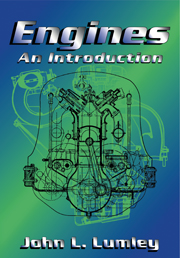2 - BREATHING EXERCISES
Published online by Cambridge University Press: 05 June 2012
Summary
INTRODUCTION
When the flow velocity through an orifice reaches the local speed of sound, a change in the pressure downstream of the orifice can no longer be communicated to the flow upstream of the orifice. This is because the message would have to travel upstream as a pressure wave at the speed of sound, and it cannot do this if the stream is flowing against it at this speed. The flow is called choked, and the mass flow rate cannot be increased beyond this point. We call the ratio of the local fluid speed U to the speed of sound a, the Mach number M = U/a. When the M = 1 at the orifice, the flow is choked (see, for example, [31]).
It is at first surprising that sonic conditions, or supersonic flow, have anything to do with an automobile engine. It turns out, however, that the flow through the inlet valve becomes choked under normal operating conditions, and this is one of the most serious limitations on the performance of an engine. The design of the valve gear is dictated largely by the need to avoid choked flow throughout the desired performance range. The desired upper end of the performance range determines when the flow through the inlet valve will become choked.
In order to control the engine speed at which the flow becomes choked, the engine designer must control the size and lift and number of the inlet valves, and this influences the combustion chamber shape, as well as the nature of the valve gear (for example, pushrod, overhead cam, double overhead cam).
Information
- Type
- Chapter
- Information
- EnginesAn Introduction, pp. 33 - 94Publisher: Cambridge University PressPrint publication year: 1999
